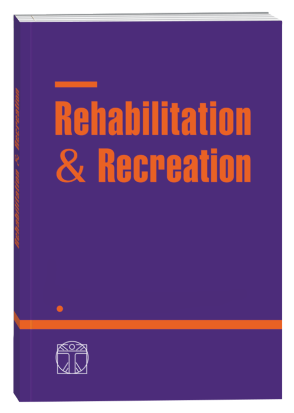APPLICATION OF THE COMPLEX OF POSTISOMETRICAL RELAXATION EXERCISES AS A PHYSIOTHERAPEUTIC METHOD OF POST-LOADING RECOVERY IN ATHLETES
DOI:
https://doi.org/10.32782/2522-1795.2023.15.17Keywords:
postisometric relaxation, non-functional overload, post-load recovery.Abstract
The purpose of the article is to study the effectiveness of post-isometric relaxation in track and field athletes in relation to mobility, the analysis of data from the Internet, foreign and domestic authors regarding the methods of recovery of athletes after excessive physical exertion, and to propose a set of post-isometric relaxation exercises as a physiotherapeutic method of post-exercise recovery in athletes. Material. The analysis of special scientific and methodical literature included printed literary sources and databases Scopus, SPORT Discus, Web of Science, Scholar. The research sample consisted of publications that were displayed using the following keywords: postisometric relaxation, nonfunctional overload, postload recovery, as well as their corresponding abbreviations and combinations. 48 domestic and foreign sources regarding methods of recovery of track and field athletes were analyzed. The results. Manual recovery techniques are popular and offer a diverse range of post-exercise recovery options for athletes and their supporting clinicians. These techniques are designed to minimize the negative effects of training or competition, thus allowing the athlete to return to peak performance more quickly. Modern data show improvement in the recovery of athletes using postisometric muscle relaxation exercises, increase blood flow, reduce muscle and nerve tension, increase range of motion, elasticity, general relaxation, reduce the intensity of delayed muscle pain and anxiety, improve the performance of athletes and reduce the risk of injury. Other popular modalities such as compression devices, whole body cryotherapy, shock gun therapy, neuromuscular electrical stimulation, and pulsed electromagnetic therapy do not have conclusive evidence for athlete recovery. Endurance athletes typically alternate periods of intense training with periods of rest and recovery to achieve peak performance. Inadequate recovery can disrupt the growth and regeneration of musculoskeletal tissues and lead to overuse damage. During major tournaments, the incidence of injuries and illnesses can reach 235 per 1,000 registered track and field athletes. It has been shown that sleep optimization, massage, cold immersion, and post-isometric relaxation are effective for the recovery of athletes of various sports. Effective recovery reduces injury rates and can improve performance; however, the development and implementation of effective recovery methods is a challenge for professionals working with track and field athletes. Conclusions. To achieve optimal performance, endurance athletes must implement a variety of recovery strategies that are specific to their training and competition. Recovery is a multidimensional process that includes physiological, psychological, emotional, social, and behavioral aspects. Achieving an appropriate balance between training and competitive stress and recovery is essential to maximizing athlete performance. A wide range of recovery techniques are now used as an integral part of the training programs of elite athletes to help achieve this balance.
References
Aboagye, E., Lilje, S., Bengtsson, C., Peterson, A., Persson, U., Skillgate, E. (2022). Manual therapy versus advice to stay active for nonspecific back and/or neck pain: a cost-effectiveness analysis. Chiropr Man Therap. 2022 May 16;30(1):27. doi: 10.1186/s12998-022-00431-7.
Aicale, R., Tarantino, D., Maffulli, N. (2018). Overuse injuries in sport: a comprehensive overview. J Orthop Surg Res. 2018 Dec 5;13(1):309. doi: 10.1186/s13018-018-1017-5.
Bezuglov E., Lazarev A., Khaitin V., Chegin S., Tikhonova A., Talibov O., Gerasimuk D., Waśkiewicz Z. (2021). The Prevalence of Use of Various Post-Exercise Recovery Methods after Training among Elite Endurance Athletes. Int J Environ Res Public Health. 2021 Nov 7;18(21):11698. doi: 10.3390/ ijerph182111698.
Braun-Trocchio R., Graybeal A., Kreutzer A., Warfield E., Renteria J., Harrison K., Williams A., Moss K., Shah M. (2022). Recovery Strategies in Endurance Athletes. J Funct Morphol Kinesiol. 2022 Feb 13;7(1):22. doi: 10.3390/jfmk7010022.
Carrard J., Rigort A., Appenzeller-Herzog C., Colledge F., Königstein K., Hinrichs T., Schmidt-Trucksäss A. (2022). Diagnosing Overtraining Syndrome: A Scoping Review. Sports Health. 2022 Sep-Oct;14(5):665-673. doi: 10.1177/19417381211044739.
Doherty R., Madigan S., Nevill A., Warrington G., Ellis J. (2021). The Sleep and Recovery Practices of Athletes. Nutrients. 2021 Apr 17;13(4):1330. doi: 10.3390/nu13041330.
Gabriel A., Konrad A., Roidl A., Queisser J., Schleip R., Horstmann T., Pohl T. (2022). Myofascial Treatment Techniques on the Plantar Surface Influence Functional Performance in the Dorsal Kinetic Chain. J Sports Sci Med. 2022 Feb 15;21(1):13-22. doi: 10.52082/jssm.2022.13.
Gräf J., Lüdtke K., Wollesen B. (2022). Physio- und sporttherapeutische Interventionen zur Behandlung eines Karpaltunnelsyndroms : Eine systematische Übersichtsarbeit [Physiotherapy and sports therapeutic interventions for treatment of carpal tunnel syndrome : A systematic review]. Schmerz. 2022 Aug;36(4):256-265. German. doi: 10.1007/s00482-022-00637-x. Epub 2022 Mar 14.
Khan Z., Ahmed S., Baig A., Farooqui W. (2022). Effect of post-isometric relaxation versus myofascial release therapy on pain, functional disability, rom and qol in the management of non-specific neck pain: a randomized controlled trial. BMC Musculoskelet Disord. 2022 Jun 13;23(1):567. doi: 10.1186/ s12891-022-05516-1.
Lei T., Huang Y., Zhou Z. (2022). Occupational Therapy and Prevention of Common Sports Injuries for Special Physical Training. Occup Ther Int. 2022 Jul 5;2022:6227377. doi: 10.1155/2022/6227377.
Paoletta M., Moretti A., Liguori S., Snichelotto F., Menditto I., Toro G., Gimigliano F., Iolascon G. (2021). Ultrasound Imaging in Sport-Related Muscle Injuries: Pitfalls and Opportunities. Medicina (Kaunas). 2021 Sep 29;57(10):1040. doi: 10.3390/ medicina57101040.
Selmi O., Ouergui I., Muscella A., My G., Marsigliante S., Nobari H., Suzuki K., Bouassida A. (2022). Monitoring Psychometric States of Recovery to Improve Performance in Soccer Players: A Brief Review. Int J Environ Res Public Health. 2022 Jul 31;19(15):9385. doi: 10.3390/ijerph19159385.
Zhang H., Zhao M., Wu Z., Wang X., Jiang Y., Liang J., Chen H. (2022). Effects of Acupuncture, Moxibustion, Cupping, and Massage on Sports Injuries: A Narrative Review. Evid Based Complement Alternat Med. 2022 May 28;2022:9467002. doi: 10.1155/2022/9467002.
Downloads
Published
How to Cite
Issue
Section
License

This work is licensed under a Creative Commons Attribution-NonCommercial-NoDerivatives 4.0 International License.











